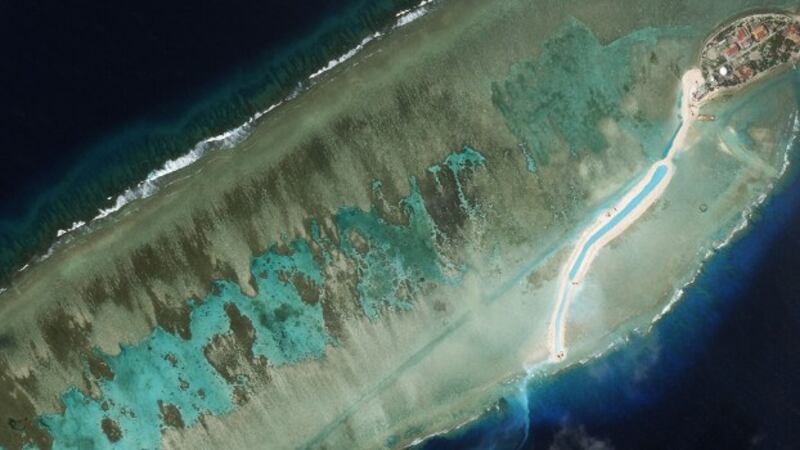UPDATED at 09:10 a.m. EST on 2021-11-01
Commercial satellite imagery suggests that Chinese vessels returning in increasing numbers to Whitsun Reef where hundreds of its ships gathered earlier this year, prompting a diplomatic dispute between Beijing and Manila.
Planet Labs images from Monday and preceding days show dozens of ships near the reef in the northern part of the Union Banks in the disputed South China Sea. Manila calls the reef Julian Felipe and said it is within its exclusive economic zone (EEZ), but China and Vietnam have separate claims to it.
The Asia Maritime Transparency Initiative (AMTI) based in Washington said in a recent report that the number of vessels visible in satellite imagery near Whitsun Reef "has been rising over the past three months,” and that most of them are Chinese.
“These numbers include some Vietnamese coastguard and fishing boats, but the vast majority are Chinese fishing vessels 50 meters or more in length. This easily distinguishes them from their smaller Vietnamese counterparts,” it said.
AMTI, which follows the ships’ movements closely, also said they appear to belong to China’s growing maritime militia since they show no evidence of fishing.
About 40 ships were spotted in August in the northern half of Union Banks, which includes Whitsun Reef, but the number had increased to more than 150 in mid-October.
The latest imagery also appeared to show the larger type of vessels that are recognizable as Chinese, AMTI told BenarNews, an RFA-affiliated online news service, suggesting that the ships have remained in the area and some had even moved closer to Whitsun Reef.
March standoff
Philippine officials did not immediately comment on the development.
Whitsun Reef is 175 nautical miles west Palawan Island in the Philippines and 638 nautical miles from China’s Hainan Island.
Manila protested in March when its military reported hundreds of Chinese ships were mooring at Whitsun Reef.
On March 22, the Philippines filed a diplomatic protest demanding that China withdraw its “maritime militia” vessels from what it the West Philippine Sea, Manila’s name for its claimed territories within the South China Sea.
China denied the reports, saying its fishing ships were seeking shelter from rough weather conditions.
The standoff continued well into April with the Philippines lodging more diplomatic protests against Chinese “incursions” into its EEZ. By the end of May, 100 diplomatic notes had been filed.
The number of Chinese ships reduced substantially afterward, but Philippine media reported that in mid-June, it increased again to more than 200 in the Union Banks including Whitsun Reef.
China claims “historical rights” to most of the South China Sea despite protests from neighboring countries.
Beijing has deployed People’s Armed Forces Maritime Militia ships in disputed waters. These are ostensibly fishing ships, although they do not engage in fishing but instead “fly the flag” for Beijing in disputed waters without an overt display of military force that would draw international condemnation.
Several countries including the United States, United Kingdom, Canada, Japan and Australia spoke in support of the Philippines in the Whitsun incident.

Construction continues
In another development, Vietnam appears to be continuing construction work on Pearson Reef in the Spratly Islands.
Vietnam has occupied the reef since 1978 and has reclaimed about six acres of land there.
RFA was the first media outlet to report on new construction and land-filling activities on Pearson Reef on Oct. 20, based on satellite imagery obtained that day.
Planet Labs imagery taken on Oct. 30 and Oct. 31 show additional developments, with what appears to be dredging work leaving a long “tail” of turbulence and sediment at the southern tip of the reef.
Most of the landfill on Pearson was done before 2014 but there seems to be renewed efforts to strengthen the reclaimed reef.
“Vietnam is clearly dredging a deeper channel to allow easier access to its facility,” said Greg Poling, AMTI’s director.
“Vietnam has done this at most of its larger facilities now,” he said.
Vietnam has 49 or 51 outposts spread across 27 features, AMTI said, adding that there is evidence of reclamation at 10 of the features totalling more than 120 acres of new land by 2016.
Vietnamese experts said their country carries out works to prevent erosion and landslides to protect the features but not to expand or change the structures of islands under its control.
